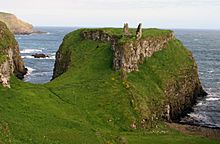Dunseverick Castle facts for kids
Quick facts for kids Dunseverick Castle |
|
|---|---|
| County Antrim, Northern Ireland | |

Dunseverick Castle
|
|
| Coordinates | 55°14′18″N 6°26′54″W / 55.238369°N 6.448230°W |
| Type | Castle |
| Site information | |
| Controlled by | Northern Ireland Environment Agency |
| Open to the public |
Yes |
| Condition | In ruins |
Dunseverick Castle is an old castle in County Antrim, Northern Ireland. It's close to the small village of Dunseverick and the famous Giant's Causeway. This castle and its surrounding earthworks are protected as important historic sites.
A local farmer named Jack McCurdy gave Dunseverick Castle and the land around it to the National Trust in 1962. The National Trust helps protect special places. A walking path called the Causeway Cliff Path goes right by the castle. It leads to Dunseverick Harbour and the Giant's Causeway.
Contents
Discover the History of Dunseverick Castle
Early Visitors and Important Events
Did you know that Saint Patrick visited Dunseverick Castle a very long time ago? This was in the 5th century AD. He is said to have baptized a local man named Olcán here. Olcán later became an important religious leader in Ireland.
The original stone fort at this spot was attacked by Vikings in 870 AD. Vikings were fierce raiders from Scandinavia.
A Royal Seat and Ancient Stone
In the late 6th century AD, Dunseverick Castle was the home of Fergus Mor MacEirc, also known as Fergus the Great. He was the King of Dál Riata. This kingdom included parts of Ireland and Scotland.
Fergus was also the great-uncle of Muirceartaigh MacEirc, a very powerful High King of Ireland. In 500 AD, an important stone called the Lia Fáil left Ireland from Dunseverick. This stone was used to crown kings. Muirceartaigh loaned it to Fergus for his coronation in Scotland.
Who Owned the Castle?
The O'Cahan family owned Dunseverick Castle for many years. They held it from about 1240 AD to 1320 AD. They then got it back in the mid-16th century.
The last O'Cahan to live at the castle was Giolla Dubh Ó Catháin. He left in 1657. Later, his family used the English name McCain or O'Kane.
The Castle's Destruction
Sadly, Dunseverick Castle was captured and destroyed in the 1600s. General Robert Monro and his troops attacked it in 1642. Later, Oliver Cromwell's soldiers finished the job in the 1650s.
Today, only the ruins of the gatehouse remain. A small tower that people used to live in stood until 1978. But it eventually fell into the sea below.
A Key Ancient Site
Dunseverick Castle was a very important place in ancient Ireland. It was the end point of one of Ireland's five great royal highways. This road was called Slige Midluachra.
It ran all the way from Dunseverick to Navan Fort, and then to Hill of Tara. It even went to a crossing point on the River Liffey, where Dublin is today.


